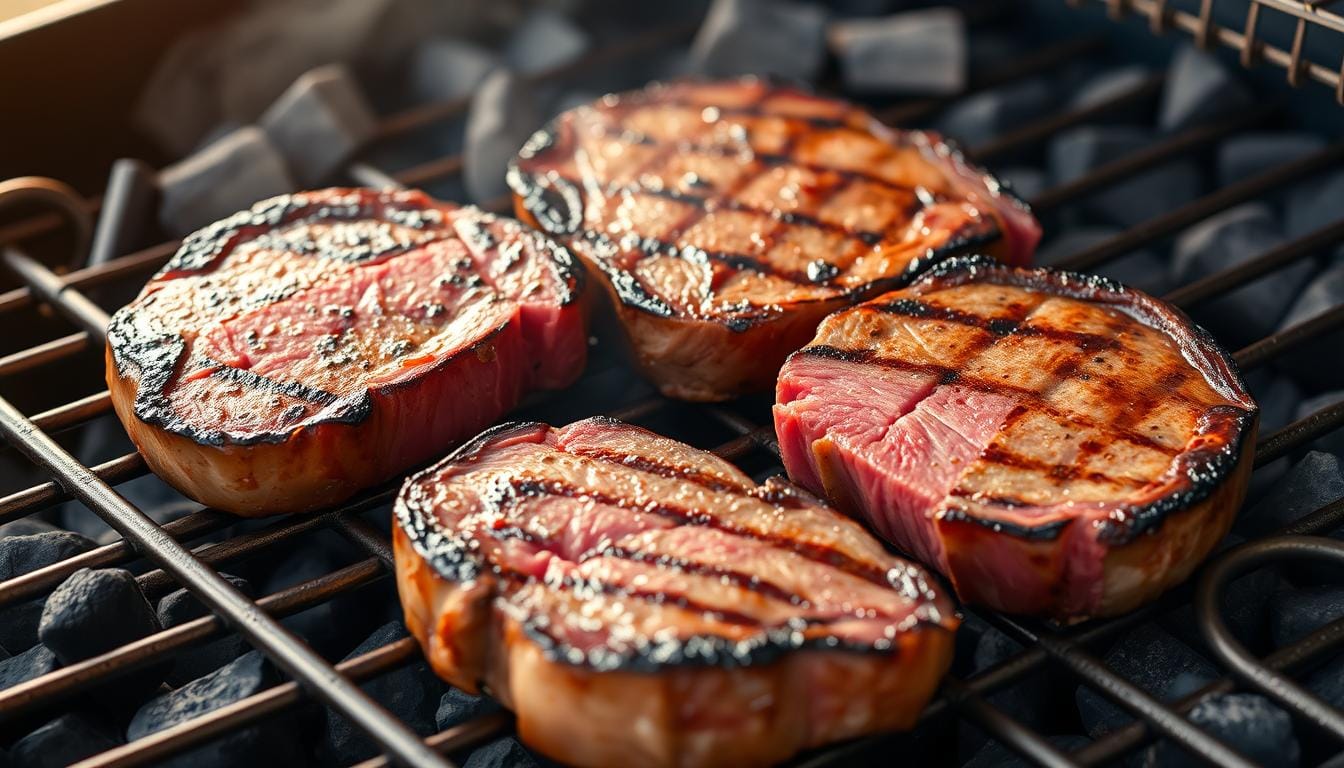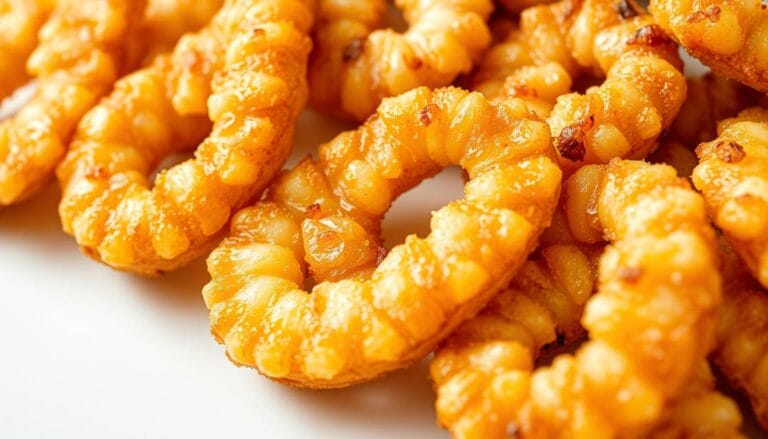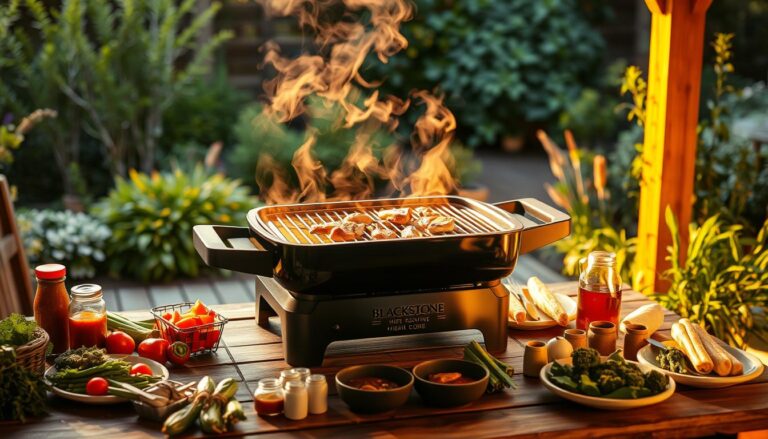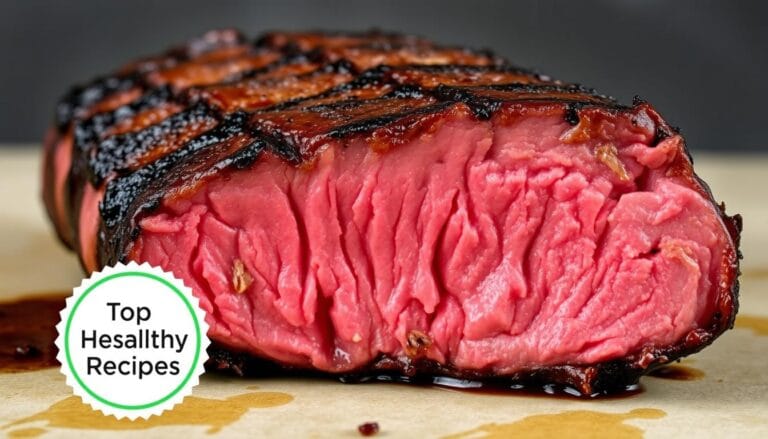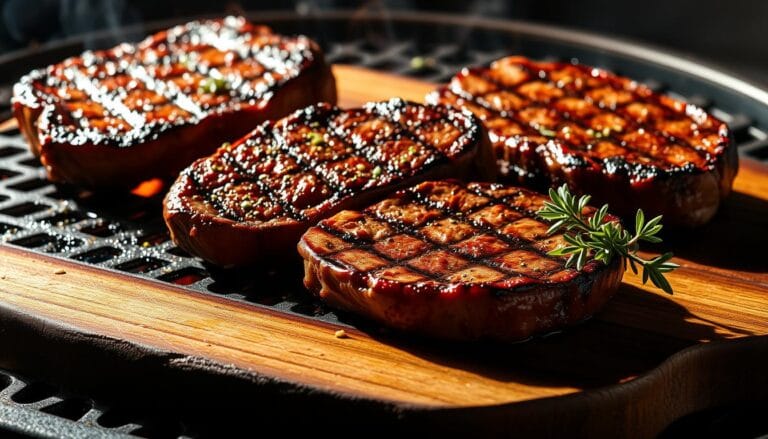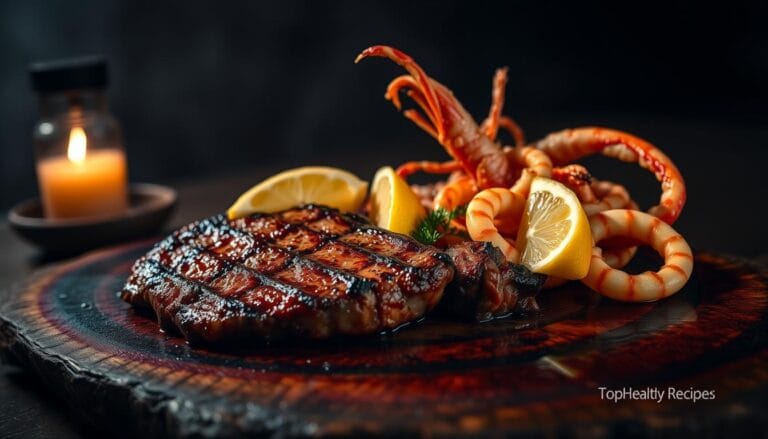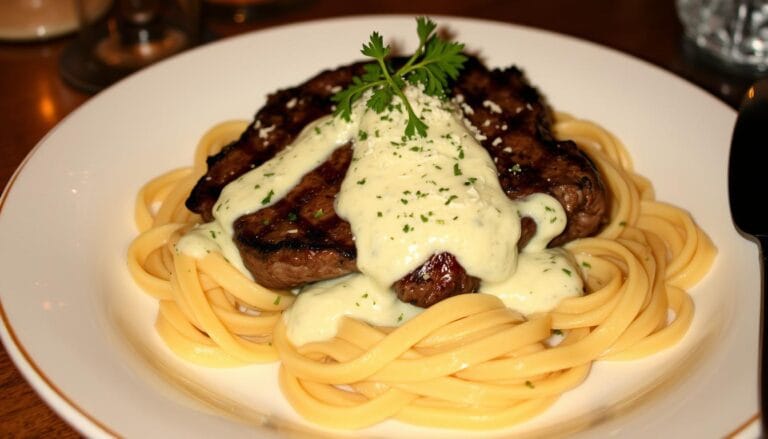Rump Steaks: Tender, Tasty, and Perfect for Grilling or Pan Searing
Table of Contents
Rump Steaks: Tender, Tasty, and Perfect for Grilling or Pan Searing
Rump steaks are a favorite among beef lovers for their tenderness and flavor. If you’ve enjoyed a well-cooked beef cut before, you’ll love rump steaks. They offer a unique taste experience.
Rump steaks are known for their rich flavor and easy cooking. They’re great for grilling or pan-searing. This cut balances tenderness and taste perfectly.
Key Takeaways
- Understanding the characteristics of rump steaks
- Learning various cooking methods for rump steaks
- Discovering tips for selecting and preparing rump steaks
- Exploring serving suggestions to enhance your dining experience
- Mastering the art of grilling and pan-searing rump steaks
What Are Rump Steaks?
Rump steaks come from the cow’s rear section. They are tender and have a rich flavor. Knowing about the cut and its qualities is key to understanding their uniqueness.
Understanding the Cut of Meat
The rump steak is from the cow’s hindquarter. This area is famous for tender cuts because of the muscle structure. The muscles here are less stressed, making the steak tender when cooked right. The anatomical location greatly affects the steak’s texture and taste, making it a hit among steak lovers.
The cut has moderate marbling, which adds to its flavor and tenderness. Marbling is the fat within the meat that improves taste and texture when cooked.
Origin and Characteristics
Rump steaks have been a staple in many cuisines for their rich flavor and cooking versatility. Unlike other cuts, rump steaks offer a unique balance of flavor and tenderness. Their marbling not only boosts flavor but also looks great when cooked.
| Characteristics | Description | Benefit |
|---|---|---|
| Anatomical Location | Cut from the hindquarter | Tender due to less stressed muscle fibers |
| Marbling | Moderate intramuscular fat | Enhanced flavor and tenderness |
| Culinary Use | Versatile in cooking methods | Suitable for grilling, pan-searing, and more |
When picking rump steaks, look for visual cues like a vibrant red color and even marbling. They are usually 1-1.5 inches thick, perfect for most cooking methods.
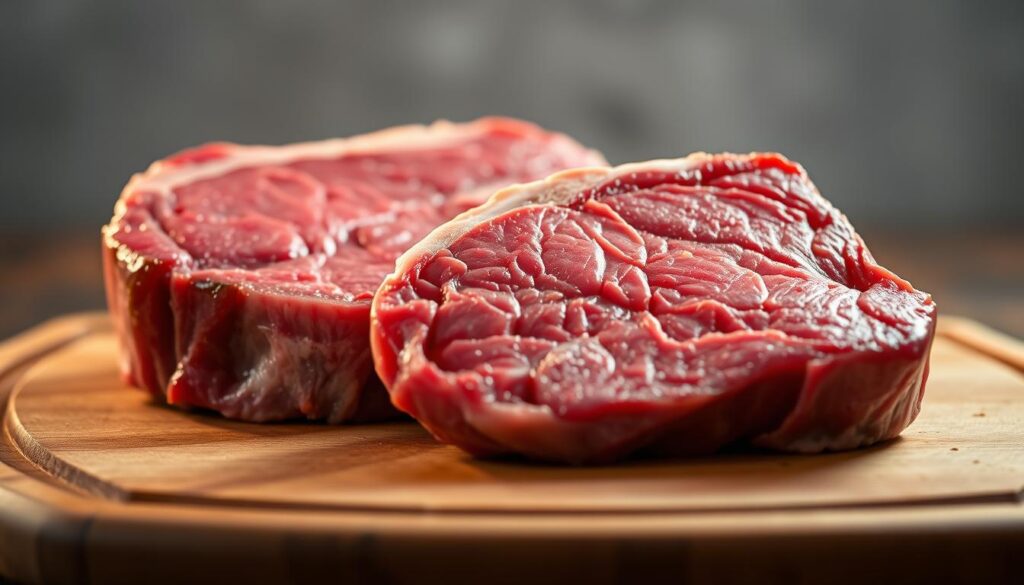
Nutritional Benefits of Rump Steaks
Rump steaks are full of nutrients that boost your health. They are rich in macronutrients and micronutrients. This makes them a great choice for a healthy diet.
They are known for their high protein and vitamins and minerals. These nutrients are essential for your body.
High Protein Content
Rump steaks have about 25-30 grams of protein per 100 grams. This is great for muscle growth and maintenance. They are perfect for those who want to stay fit or maintain health.
The protein in rump steaks is of high quality. It has all the amino acids your body needs.
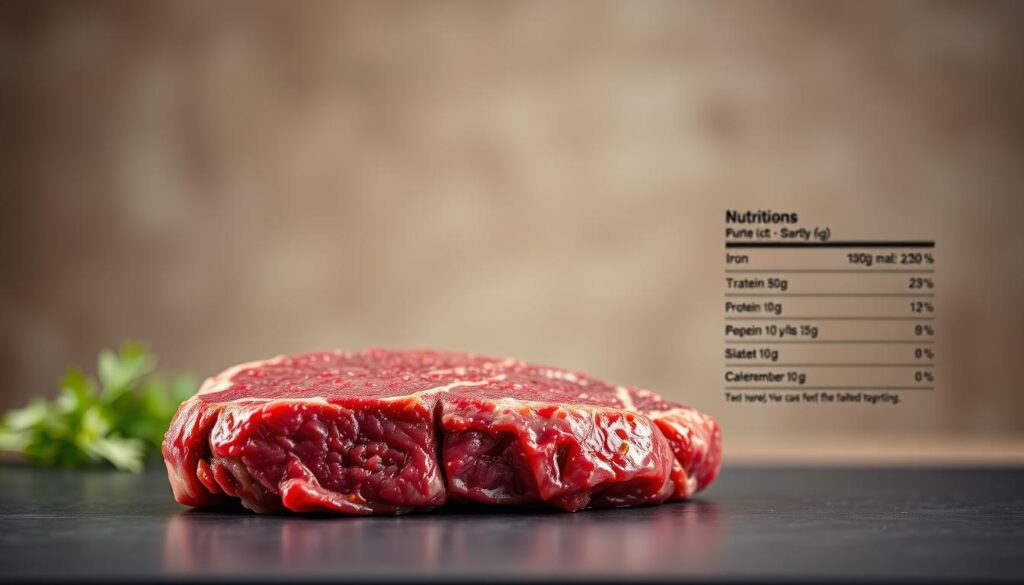
Essential Vitamins and Minerals
Rump steaks are also full of vitamins and minerals. They have a lot of iron, which is good for your blood. They also have zinc, B vitamins, phosphorus, and selenium.
These nutrients are important for your immune system and energy. They help your body work well.
Yes, rump steaks have fat, but you can choose wisely. Pick leaner cuts or trim fat to balance your diet. Adding rump steaks in moderation can be good for you.
How to Choose the Perfect Rump Steak
Choosing the right rump steak is about knowing a few key things. These things affect how tasty and tender it will be. Look for freshness and understand the quality grading to get the best steak.
Freshness Indicators
Freshness is key when picking a rump steak. Here are some signs to look for:
- Color: It should be a bright red. Stay away from steaks that are brown or gray.
- Packaging Liquid: Little liquid is a good sign. Too much might mean it’s old or handled wrong.
- Smell: A fresh steak smells clean and fresh. Bad smells mean it’s gone bad.
- Firmness: It should feel firm, not soft or squishy.
- Cut Date: Check the cut date if you can. It helps ensure it’s as fresh as possible.
Quality Grading
Knowing the quality grading of rump steaks is important. It helps you get a tender and tasty steak. The USDA grading system is a good place to start:
- Prime: These steaks are top-notch with lots of marbling. This makes them taste better and be more tender.
- Choice: These steaks have some marbling. They’re less expensive but are tasty and tender too.
- Select: These are leaner steaks with less marbling. They’re cheaper but might not be as tender.
Also, think about the steak’s thickness (1-1.5 inches is best). And whether you want it bone-in or boneless. These choices can change how it cooks.
Preparing Rump Steaks for Cooking
Getting your rump steak ready is key to a great meal. It starts with knowing how to handle the meat. Before you cook, make sure to prepare your steak to bring out its best flavors and texture.
Trimming and Marinating
First, check your steak for too much fat. Some fat is good for taste, but too much can be trimmed for better balance. Also, look for silverskin, a tough part that can make the steak chewy. Removing it makes the steak softer.
Marinating is also important. A good marinade tenderizes the meat and adds flavor. Marinating time varies from 2 to 24 hours, depending on the ingredients. Acidic items like vinegar or yogurt make the steak tender. Oil-based marinades, on the other hand, add more flavor. Try a mix of olive oil, garlic, and herbs like thyme or rosemary.
Recommended Seasonings
Seasoning lets you play with flavors. Salt, pepper, and garlic are simple yet effective. They enhance the steak’s flavor without overpowering it. For more complex tastes, try herb blends or spice rubs. A mix of paprika, garlic powder, and onion powder is classic. For something spicier, add chili powder and cumin.
Choose your seasonings wisely. Let your steak come to room temperature before cooking. This takes 30 to 60 minutes for even cooking. Also, dry the steak with paper towels before cooking. This helps get a better sear by removing moisture.
| Seasoning Type | Ingredients | Flavor Profile |
|---|---|---|
| Simple | Salt, Pepper, Garlic | Classic, Robust |
| Herb Blend | Thyme, Rosemary, Garlic | Aromatic, Savory |
| Spice Rub | Paprika, Garlic Powder, Onion Powder | Smoky, Complex |
By following these steps, you’ll cook a tender and flavorful rump steak.
Grilling Rump Steaks: A Step-by-Step Guide
Rump steaks are perfect for grilling, giving you tender and tasty results. To get the best results, follow these key steps.
Ideal Grill Temperature
Getting your grill to the right temperature is key. For gas grills, aim for 450-500°F (232-260°C). Charcoal grills need coals that are white-hot. Having dual heat zones lets you sear the steak and then cook it lower if needed.
Preparation is key: Clean and oil the grates before grilling. This prevents the steak from sticking, improving your grilled rump steak’s quality.
Cooking Times and Techniques
Grilling involves several steps, from searing to finishing. Start by searing the steak over high heat for 2-3 minutes per side. For thicker steaks, use indirect heat to finish cooking.
For medium doneness, use the “7-5-3” method. Grill for 7 minutes on the first side, 5 on the second, and rest for 3 minutes. Adjust based on steak thickness and desired doneness.
| Doneness Level | Internal Temperature (°F) | Grilling Time (minutes) |
|---|---|---|
| Rare | 130-135 | 4-5 |
| Medium Rare | 135-140 | 5-6 |
| Medium | 140-145 | 7-8 |
Knowing when to close the grill lid and how to handle flare-ups is important. Closing the lid helps cook evenly, and moving the steak away from flare-ups works too. Letting the steak rest after cooking makes it more tender and flavorful.
Pan Searing Rump Steaks
Getting a perfectly cooked rump steak indoors is simpler than you might think. Pan searing gives you a crispy crust on the outside and a juicy, tender inside.
Equipment You’ll Need
To pan sear rump steaks well, you need the right tools. A heavy-bottomed cast iron or carbon steel pan is best. It keeps heat well for a consistent sear. You’ll also need tongs for flipping and an instant-read thermometer to check if it’s done.
- A heavy-bottomed cast iron or carbon steel pan
- Tongs for flipping
- An instant-read thermometer
- High smoke-point oil or fat for cooking
- Optional: a kitchen torch for finishing or a weight/press for even contact
Tips for Searing Perfectly
To get a perfect sear, start by heating your pan until it’s smoking. Then, add a small amount of high smoke-point oil or fat. Place your rump steak in the pan and let it sear for the right time based on your desired doneness.
For extra flavor, try the butter basting method in the last minutes of cooking. Add butter, garlic, and herbs to the pan and spoon the flavored fat over the steak. It’s important to manage splatter and know when to flip the steak for a smooth cooking process.
Key tips for pan searing:
- Don’t overcrowd the pan.
- Adjust cooking times based on your stove and cookware.
- Use a thermometer to ensure the steak is cooked to your desired doneness.
By following these tips and using the right equipment, you can make a delicious rump steak indoors. Try different seasonings and sides to make your meal even better.
Doneness Levels and How to Achieve Them
Getting the perfect doneness for your rump steak is key for a great meal. The doneness level changes the steak’s texture, juiciness, and taste. Whether you’re an expert chef or just starting, knowing how to cook your steak to your liking is important.
Rare to Well-Done Guide
Cooking a rump steak to the right doneness means knowing the different levels. Each level has its own temperature range and characteristics.
| Doneness Level | Temperature Range (°F) | Description |
|---|---|---|
| Rare | 120-130 | Cool red center, juicy, and tender. |
| Medium Rare | 130-135 | Warm red center, firmer than rare but juicy. |
| Medium | 140-145 | Partially pink center, balance of juiciness and firmness. |
| Medium Well | 150-155 | Slightly pink center, how to cook a rump steak medium for a tender yet cooked steak. |
| Well Done | 160+ | No pink color, fully cooked, and firmer texture. |
Using a Meat Thermometer
A meat thermometer is a precise tool for checking your rump steak’s doneness. There are instant-read digital thermometers and leave-in probe thermometers.
To use a thermometer, insert it into the thickest part of the steak, avoiding bones or fat. It’s also important to know about carryover cooking. This is when the steak’s temperature goes up by 5-10°F while it rests.
Sides That Pair Well with Rump Steaks
Choosing the right sides for your rump steak can make your meal better. The right side dish can match the steak’s flavor, making your meal complete.
Classic Side Dishes
Traditional sides are loved for a reason. Roasted potatoes and sautéed mushrooms are favorites because they go well with steak. Roasted potatoes taste great with herbs like rosemary and thyme. Mushrooms, like shiitake or cremini, add a rich flavor.
Grilled asparagus and creamed spinach are also great choices. Asparagus adds a fresh taste, while spinach brings creaminess. These sides not only taste good but also look great on your plate.
Creative Pairing Ideas
Want to try something new? Chimichurri-dressed grilled vegetables are a vibrant choice. Grill your favorite veggies and top them with a tangy chimichurri sauce.
Other creative ideas include blue cheese polenta and roasted bone marrow. Polenta is creamy and tangy, while bone marrow is rich. For a light option, try an Asian-inspired quick-pickled slaw with cabbage and carrots.
When picking sides, mix flavors and textures. Pair the savory steak with fresh or tangy sides. Add crunchy, crispy, or creamy textures for a fun meal. Don’t forget to choose a drink, like a red wine or beer, to make your meal even better.
Serving Suggestions for Rump Steaks
Mastering the perfect rump steak is just the start. Now, focus on how to present it to impress your guests. The way you present it can make a big difference in the dining experience.
Presentation Techniques
To make your rump steak look great, slice it against the grain at a 45-degree angle. This makes it tender and adds a touch of professionalism to your dish.
Place the sliced steak on a warmed plate. Use negative space to make it look clean and inviting. Add fresh herbs or microgreens for a burst of color and freshness.
Accompaniments for Enhanced Flavor
Enhance the flavor of your rump steak with a compound butter or pan sauce. Try herb butter, blue cheese butter, or a red wine reduction for depth and richness.
For extra flavor, serve condiments like horseradish cream, chimichurri, or béarnaise sauce on the side. These can change the taste experience and please different tastes.
| Accompaniment | Description | Flavor Profile |
|---|---|---|
| Herb Butter | A compound butter made with fresh herbs | Fresh, aromatic |
| Red Wine Reduction | A rich sauce made by reducing red wine | Fruity, intense |
| Horseradish Cream | A creamy condiment with a spicy kick | Spicy, tangy |
Whether it’s a family-style meal or a formal event, keep the steak warm from kitchen to table. Use chafing dishes or warming trays to keep it at the perfect temperature.
Storing Leftover Rump Steaks
When you’ve cooked more rump steak than you can eat at once, it’s key to know how to store leftovers. This keeps your leftover rump steak safe to eat and keeps its quality for later meals.
Cooling and Storage
To store leftover rump steak, cool it down within two hours of cooking to stop bacteria from growing. Wrap the steak tightly in aluminum foil or plastic wrap. Then, put it in an airtight container. This double-layer wrapping keeps moisture and contaminants out.
Put the wrapped rump steak in the fridge, away from raw foods to prevent cross-contamination. The best spot is on the middle or bottom shelf, where it stays cool.
- Cool the steak within two hours of cooking.
- Wrap tightly in aluminum foil or plastic wrap.
- Place the wrapped steak in an airtight container.
- Store away from raw foods.
Reheating Tips
When reheating leftover rump steak, be careful not to overcook it. A good method is to use a low-temperature oven. Set your oven to 275°F (135°C) and warm the steak gently until it’s just hot. This keeps the steak tender and flavorful.
Another way is the “sear and steam” pan method. Sear the steak briefly in a hot pan to crisp the outside. Then, add a bit of liquid (like broth or wine) to the pan, cover it, and steam the steak for a few minutes until it’s warm.
Leftover rump steak can be used in many tasty dishes. Slice it thinly for steak sandwiches, chop it for salads, or add it to stir-fries. You can also dice it and mix it into a breakfast hash for a filling morning meal.
- Steak sandwiches: Slice the leftover steak thinly and serve on a crusty baguette.
- Salads: Chop the steak into bite-sized pieces and toss with your favorite greens and dressing.
- Stir-fries: Slice the steak into strips and stir-fry with your favorite vegetables and seasonings.
Common Mistakes to Avoid When Cooking Rump Steaks
To cook a perfect rump steak, you must avoid common mistakes. These errors can make your dish less tasty. Knowing what to watch out for ensures a great meal.
Overcooking Concerns
One big mistake is overcooking rump steaks. They can become tough and dry if cooked too long. It’s important to know when they’re just right, not too much.
Using a timer and thermometer helps avoid overcooking. Remember, the steak will cook a bit more after it’s off the heat. Taking it off a bit early helps get the perfect doneness.
Inadequate Seasoning
Not seasoning enough is another mistake. Salt is key for flavor and texture. Pre-salting, or salting before cooking, makes a big difference. Also, don’t forget to season well to avoid under-seasoning.
Other mistakes include not letting the meat rest, cutting against the grain, and starting with cold meat. Also, don’t overcrowd the pan or flip the steak too much. Avoiding these errors will make your steak better.
Knowing these mistakes and how to avoid them will help you cook a perfect rump steak. Whether you grill or pan-fry, paying attention to detail is essential for a tasty meal.
Popular Recipes Featuring Rump Steaks
Rump steaks are great for many dishes, from grilling to tacos and stir-fries. You can try new cuisines with rump steak.
Grilled Rump Steak Tacos
Make tasty Mexican-style tacos with grilled rump steak. Mix cumin, chili powder, and oregano for a spice rub. Rub it on the steak and grill until it’s medium-rare to medium doneness.
Let the steak rest before slicing it thinly against the grain.
- Quick-pickled onions
- Cilantro
- Cotija cheese
- Lime wedges
Put the sliced steak in warmed tortillas. Add your favorite toppings. Warm tortillas by wrapping them in foil and heating on the grill or in a skillet.
Rump Steak Stir-Fry
Try an Asian-style rump steak stir-fry. Slice the steak into thin strips. Freezing it for 30 minutes helps with slicing.
Marinate the strips in soy sauce, ginger, and aromatics for 30 minutes. Heat a wok or skillet over high heat. Cook the steak and then the vegetables.
- Sear the steak and set it aside.
- Cook the harder vegetables first (like bell peppers and carrots).
- Add quicker-cooking vegetables (like broccoli and snow peas).
- Return the steak to the wok or skillet to combine with the vegetables.
Using rump steak in these recipes makes for a tasty meal. It showcases the cut’s flavor and tenderness when cooked right.
Frequently Asked Questions about Rump Steaks
Exploring rump steaks can raise some questions. They are known for their rich flavor and tender texture when cooked right. But, many people wonder about their preparation and use in different dishes.
Can you use rump steak in various cuisines?
Rump steak is very versatile and can fit into many cuisines. You can marinate it in Italian seasonings for a tasty tagliata with arugula and Parmesan. Or, try a Korean-inspired marinade for a flavorful bulgogi.
The trick is to adjust your cooking and marinades for the cuisine you’re making. For example, a French steak au poivre needs a peppercorn crust. A Mexican carne asada does well with a citrus marinade.
- Grilling or pan-searing with Asian-style stir-fry vegetables
- Using it in a classic American steakhouse-style dinner with roasted vegetables
- Incorporating it into a hearty Italian pasta dish with a rich tomato sauce
Is rump steak tough compared to other cuts?
Rump steak might be chewier than tender cuts like tenderloin or ribeye. But, it has better flavor at a lower price. The tenderness of rump steak depends on how you prepare it.
Marinating can make the meat tender. Cooking it to the right doneness and slicing it against the grain also improves its texture.
Here are some tips to enjoy a tender and flavorful rump steak:
- Marinate the steak for at least 30 minutes to tenderize it.
- Cook the steak to your desired level of doneness using a meat thermometer.
- Let the steak rest before slicing it thinly against the grain.
By following these tips, you can have a tender and flavorful rump steak. It’s perfect for any meal, whether you’re grilling or pan-searing. Knowing how to make rump steak shine is key to a great meal.
Conclusion: Enjoying Your Rump Steaks
Learning to cook rump steaks can boost your cooking skills and make a tasty meal for any event. Knowing how to cook this cut can lead to a perfectly cooked steak.
Perfecting Your Technique
For success, choose high-quality meat, let it come to room temperature, and season well. Use high heat for the first sear and watch the steak’s doneness closely. Letting the steak rest before slicing makes it tender and flavorful.
With more practice, you’ll get better at making amazing rump steaks.
Exploring Flavor Options
Try out different rump steak recipes and seasonings. Rump steak’s strong flavor is perfect for trying new things. Whether grilling or pan-searing, you can make many dishes that you’ll love.
Adding rump steak to your cooking routine means you’ll enjoy a tasty, versatile, and affordable cut. Try different recipes to find your new favorites.
FAQ
Can you use rump steak in various cuisines?
Is rump steak tough compared to other cuts?
How do you cook a rump steak medium well?
What are some rump steak recipes?
How do you make rump steak tender?
Can you substitute rump steak for other cuts in recipes?
Is rump steak suitable for slow cooking methods?
Does grass-fed versus grain-fed make a difference for rump steak?
For more cooking tips, stay connected with us. We also recommend the cookbook Skinnytaste Simple: Easy, Healthy Recipes with 7 Ingredients or Fewer
For more Recipes about Steak ?
Did You try our recipe ?
There are no reviews yet. Be the first one to write one.
